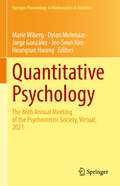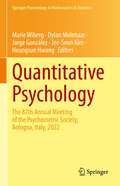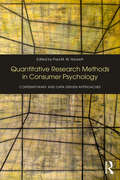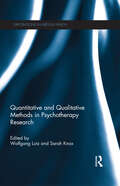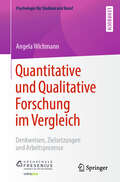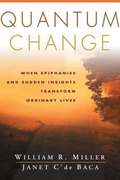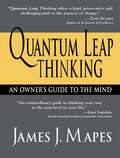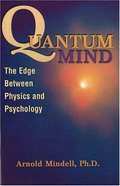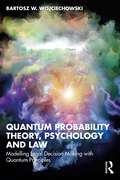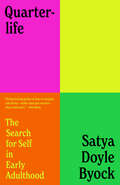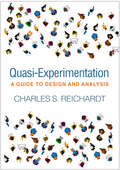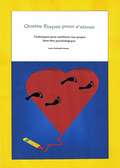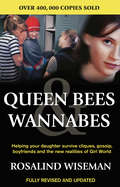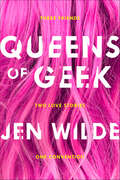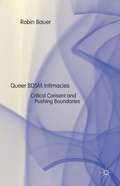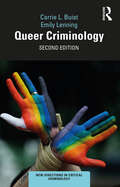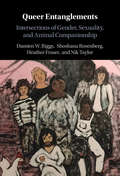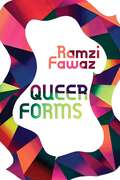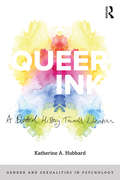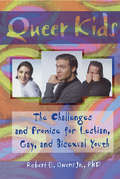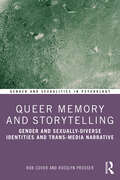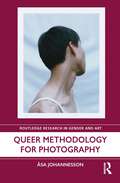- Table View
- List View
Quantitative Psychology: The 86th Annual Meeting of the Psychometric Society, Virtual, 2021 (Springer Proceedings in Mathematics & Statistics #393)
by Marie Wiberg Jorge González Dylan Molenaar Heungsun Hwang Jee-Seon KimThe volume represents presentations given at the 86th annual meeting of the Psychometric Society, held virtually on July 19–23, 2021. About 500 individuals contributed paper presentations, symposiums, poster presentations, pre-conference workshops, keynote presentations, and invited presentations. Since the 77th meeting, Springer has published the conference proceedings volume from this annual meeting to allow presenters to share their work and ideas with the wider research community, while still undergoing a thorough review process. This proceedings covers a diverse set of psychometric topics, including item response theory, Bayesian models, reliability, longitudinal measures, and cognitive diagnostic models.
Quantitative Psychology: The 87th Annual Meeting of the Psychometric Society, Bologna, Italy, 2022 (Springer Proceedings in Mathematics & Statistics #422)
by Marie Wiberg Jorge González Dylan Molenaar Heungsun Hwang Jee-Seon KimThe volume represents presentations given at the 87th annual meeting of the Psychometric Society, held in Bologna, Italy at July 11–15, 2022. The proceedings cover a diverse set of psychometric topics, including item response theory, Bayesian models, reliability, latent variable models, causal inference, and cognitive diagnostic models.
Quantitative Research Methods in Consumer Psychology: Contemporary and Data Driven Approaches
by Paul HackettQuantitative consumer research has long been the backbone of consumer psychology producing insights with peerless validity and reliability. This new book addresses a broad range of approaches to consumer psychology research along with developments in quantitative consumer research. Experts in their respective fields offer a perspective into this rapidly changing discipline of quantitative consumer research. The book focuses on new techniques as well as adaptations of traditional approaches and addresses ethics that relate to contemporary research approaches. The text is appropriate for use with university students at all academic levels. Each chapter provides both a theoretical grounding in its topic area and offers applied examples of the use of the approach in consumer settings. Exercises are provided at the end of each chapter to test student learning. Topics covered are quantitative research techniques, measurement theory and psychological scaling, mapping sentences for planning and managing research, using qualitative research to elucidate quantitative research findings, big data and its visualization, extracting insights from online data, modeling the consumer, social media and digital market analysis, connectionist modeling of consumer choice, market sensing and marketing research, preparing data for analysis;, and ethics. The book may be used on its own as a textbook and may also be used as a supplementary text in quantitative research courses.
Quantitative and Qualitative Methods in Psychotherapy Research (Explorations in Mental Health)
by Wolfgang Lutz Sarah KnoxIn this collection, international contributors come together to discuss how qualitative and quantitative methods can be used in psychotherapy research. The book considers the advantages and disadvantages of each approach, and recognises how each method can enhance our understanding of psychotherapy. Divided into two parts, the book begins with an examination of quantitative research and discusses how we can transfer observations into numbers and statistical findings. Chapters on quantitative methods cover the development of new findings and the improvement of existing findings, identifying and analysing change, and using meta-analysis. The second half of the book comprises chapters considering how qualitative and mixed methods can be used in psychotherapy research. Chapters on qualitative and mixed methods identify various ways to strengthen the trustworthiness of qualitative findings via rigorous data collection and analysis techniques. Adapted from a special issue of Psychotherapy Research, this volume will be key reading for researchers, academics, and professionals who want a greater understanding of how a particular area of research methods can be used in psychotherapy.
Quantitative und Qualitative Forschung im Vergleich: Denkweisen, Zielsetzungen und Arbeitsprozesse (Psychologie für Studium und Beruf)
by Angela WichmannDieses kompakte Lehrbuch vermittelt ein fundiertes, ganzheitliches Verständnis der Unterschiede zwischen quantitativen und qualitativen Forschungsmethoden – und ihrer jeweiligen Vor- und Nachteile. Dabei geht es weniger um die Vorstellung einzelner Methoden, sondern es wird vertieft betrachtet, worin sich grundlegende Denkweisen, Zielsetzungen und Arbeitsprozesse unterscheiden. Das Buch versteht sich somit als Begleitlektüre zu großen Methodenlehrbüchern sowie Wegweiser für alle Studierenden und angehende Forscher/-innen bei der Gestaltung eigener Forschungsvorhaben und der kritischen Rezeption wissenschaftlicher Untersuchungen – gerade in Zeiten, in denen sich enge Bindungen zwischen wissenschaftlichen Fachdisziplinen und bestimmten Forschungsmethoden zugunsten einer Offenheit für andere Herangehensweisen auflösen.
Quantum Change
by William Miller Janet C'DebacaMost of us walk through each day expecting few surprises. If we want to better ourselves or our lives, we map out a path of gradual change, perhaps in counseling or psychotherapy. Psychologists William Miller and Janet C'de Baca were longtime scholars and teachers of traditional approaches to self-improvement when they became intrigued by a different sort of change that was sometimes experienced by people they encountered something often described as "a bolt from the blue" or "seeing the light." And when they placed a request in a local newspaper for people's stories of unexpected personal transformation, the deluge of responses was astounding. These compelling stories of epiphanies and sudden insights inspired Miller and C'de Baca to examine the experience of "quantum change" through the lens of scientific psychology. Where does quantum change come from? Why do some of us experience it, and what kind of people do we become as a result? The answers that this book arrives at yield remarkable insights into how human beings achieve lasting change--sometimes even in spite of ourselves.
Quantum Leap Thinking
by James J. MapesYou've certainly hit the nail on the head. If I had read Quantum Leap Thinking at the age of 20, I could have saved many, many mistakes and a helluva lot of wasted effort. Clive Cussler, bestselling author Positive change can happen in sudden and profound leaps. Quantum Leap Thinking provides the foundation for breakthrough thinking that will trigger astonishing growth in your personal and professional life. What if it was possible to break through fear and make positive changes in your life in an instant by a simple shift in your thinking? What if you could lower your anxiety in a matter of seconds by changing your perceptions? How would your life change if you had unshakable motivation for whatever you chose to do? Quantum Leap Thinking is the key to unlocking the door to new-found potential and peak performance.
Quantum Mind: The Edge Between Physics and Psychology
by Arnold MindellBy exploring principles found in psychology, math, physics, and shamanism, it becomes possible to link a cosmic perspective with ordinary life.
Quantum Models of Cognition and Decision
by Jerome R. Busemeyer Peter D. BruzaMuch of our understanding of human thinking is based on probabilistic models. This innovative book by Jerome R. Busemeyer and Peter D. Bruza argues that, actually, the underlying mathematical structures from quantum theory provide a much better account of human thinking than traditional models. They introduce the foundations for modelling probabilistic-dynamic systems using two aspects of quantum theory. The first, 'contextuality', is a way to understand interference effects found with inferences and decisions under conditions of uncertainty. The second, 'quantum entanglement', allows cognitive phenomena to be modeled in non-reductionist ways. Employing these principles drawn from quantum theory allows us to view human cognition and decision in a totally new light. Introducing the basic principles in an easy-to-follow way, this book does not assume a physics background or a quantum brain and comes complete with a tutorial and fully worked-out applications in important areas of cognition and decision.
Quantum Probability Theory, Psychology and Law: Modelling Legal Decision Making with Quantum Principles
by Bartosz W. WojciechowskiThis book provides the first consideration of quantum principles in legal decision making. It shows how quantum probability theory can be applied to psychology and law to deepen our understanding of psychological and legal issues, suggesting a paradigm shift in the study of these areas. Written as an introduction to quantum probability theory for non-physicists, the book offers an accessible summary of how psychology can be applied to quantum phenomena for human decision making. It introduces psychologists and lawyers to fresh conceptual frameworks, including classical probability theory, classical statistics, data mining and quantum theory. Wojciechowski shows how quantum theory and concepts can be transferred to psychological research models, and can help to resolve previously unexplained psychological phenomena, influence scientific views, undermine traditional foundations of the legal system and result in the development of new research directions. Studies conducted by the author are used to show how problems facing legal decision making can be addressed in a completely new light with the application of quantum probability theory. This cutting-edge and innovative book will be of great interest to graduate students and researchers in the fields of forensic psychology and legal decision making, as well as legal professionals and legal scholars.
Quantum Social Science
by Emmanuel Haven Andrei KhrennikovWritten by world experts in the foundations of quantum mechanics and its applications to social science, this book shows how elementary quantum mechanical principles can be applied to decision-making paradoxes in psychology and used in modelling information in finance and economics. The book starts with a thorough overview of some of the salient differences between classical, statistical and quantum mechanics. It presents arguments on why quantum mechanics can be applied outside of physics and defines quantum social science. The issue of the existence of quantum probabilistic effects in psychology, economics and finance is addressed and basic questions and answers are provided. Aimed at researchers in economics and psychology, as well as physics, basic mathematical preliminaries and elementary concepts from quantum mechanics are defined in a self-contained way.
Quarterlife: The Search for Self in Early Adulthood
by Satya Doyle ByockAn innovative psychotherapist tackles the overlooked stage of Quarterlife—the years between adolescence and midlife—and provides a guide to navigate it and thrive.&“Quarterlife is an insightful, revealing look at the messy and uncharted paths to wholeness, and a powerful tool for anyone navigating early adulthood.&”—Tembi Locke, New York Times bestselling author of From Scratch I&’m stuck. What&’s wrong with me? Is this all there is? Satya Doyle Byock hears these refrains regularly in her psychotherapy practice where she works with &“Quarterlifers,&” individuals between the ages of (roughly) sixteen to thirty-six. She understands their frustration. Some clients have done everything &“right&”: graduate, get a job, meet a partner. Yet they are unfulfilled and unclear on what to do next. Byock calls these Quarterlifers &“Stability Types.&” Others are uninterested in this prescribed path, but feel unmoored. She refers to them as &“Meaning Types.&” While society is quick to label the emotions and behavior of this age group as generational traits, Byock sees things differently. She believes these struggles are part of the developmental journey of Quarterlife, a distinct stage that every person goes through and which has been virtually ignored by popular culture and psychology. In Quarterlife, Byock utilizes personal storytelling, mythology, Jungian psychology, pop culture, literature, and client case studies to provide guideposts for this period of life. Readers will be able to find themselves on the spectrum between Stability and Meaning Types, and engage with Byock&’s four pillars of Quarterlife development: • Separate: Gain independence from the relationships and expectations that no longer serve you • Listen: Pay close attention to your own wants and needs • Build: Create, cultivate, and construct tools and practices for the life you want • Integrate: Take what you&’ve learned and manifest something new Quarterlife is a defining work that offers a compassionate roadmap toward finding understanding, happiness, and wholeness in adulthood.
Quasi-Experimentation: A Guide to Design and Analysis (Methodology in the Social Sciences)
by Charles S. ReichardtFeaturing engaging examples from diverse disciplines, this book explains how to use modern approaches to quasi-experimentation to derive credible estimates of treatment effects under the demanding constraints of field settings. Foremost expert Charles S. Reichardt provides an in-depth examination of the design and statistical analysis of pretest–posttest, nonequivalent groups, regression discontinuity, and interrupted time-series designs. He details their relative strengths and weaknesses and offers practical advice about their use. Comparing quasi-experiments to randomized experiments, Reichardt discusses when and why the former might be a better choice than the latter in the face of the contingencies that are likely to arise in practice. Modern methods for elaborating a research design to remove bias from estimates of treatment effects are described, as are tactics for dealing with missing data and noncompliance with treatment assignment. Throughout, mathematical equations are translated into words to enhance accessibility. Adding to its discussion of prototypical quasi-experiments, the book also provides a complete typology of quasi-experimental design options to help the reader craft the best research design to fit the circumstances of a given study.
Quatre Étapes pour s’aimer. Techniques pour améliorer son propre bien-être psychologique
by Laura Pedrinelli Carrara Sanja AudarLA DESCRIPTION DU LIVRE Il y a les moments dans la vie où nous avons besoin de nous arrêter un instant pour comprendre ce qui se passe. Nous sentons qu’en nous-mêmes ou dans les rapports avec les autres une certaine harmonie s’est altérée ou plus que jamais nous nous apercevons qu’elle n’a jamais existé. Souvent nous nous laissons aller dans les conclusions faciles du style «Personne ne me comprend», «Je ne vaux pas grand chose», « Ils veulent ma peau», « Les autres, s’ils le peuvent, ils abusent », « La seule façon d’être bien serait de s’en aller». En réalité, on ne résout pas les problèmes avec la fugue puisque si on ne défait pas les nœuds, ce sera le retour de bâton, nous devons cependant porter l’attention adéquate à notre façon d’interagir avec les autres et de choisir les protagonistes de nos relations. Le livre Quatre Étapes pour s’aimer. Techniques pour améliorer son propre bien-être psychologique se veut être un petit outil pour commencer à comprendre en mode plus objectif et plus profond quelque chose sur nous-mêmes pour demander la compréhension émotionnelle de nous-mêmes et les modalités pour interagir avec les autres. Notamment on souhaite aider l’individu à améliorer son propre bien-être, le stimulant à évaluer les modes divers de percevoir soi-même et les autres et de gérer ses propres émotions et le stress. Le texte est composé de 4 chapitres intitulés les Étapes parce qu’elles accompagneront le lecteur participant dans le chemin divertissant et enthousiasmant à l’intérieur de lui-même. Dans chaque Étape on pourra comprendre et exprimer soi-même en modes différents, réclamant l’introspection profonde, mais jamais frustrante ou pesante. Les exercices activent l’individu sur le niveau psychocorporel, pour cette raison dans certains cas on doit compléter les phrases et répondre aux questions, dans les autre
Queen Bees And Wannabes for the Facebook Generation: Helping your teenage daughter survive cliques, gossip, bullying and boyfriends
by Rosalind WisemanWhen Rosalind Wiseman first published QUEEN BEES & WANNABEES, she fundamentally changed the way adults look at girls' friendships and conflicts - from how they choose their best friends, how they express their anger, their boundaries with boys, and their relationships with parents. Wiseman showed how girls of every background are profoundly influence by their interactions with one another.Now, Wiseman has revised and updated her groundbreaking book for a new generation of girls living in the age of Facebook, IM and text message..Packed with insights about technology's impact on Girl World and enlivened with the experiences of girls, boys, and parents, the book that inspired the hit movie Mean Girls offers concrete strategies to help you empower your daughter to be socially competent and treat herself with dignity.
Queens of Geek
by Jen WildeThree friends, two love stories, one convention: this fun, feminist love letter to geek culture is all about fandom, friendship, and finding the courage to be yourself."Full of irreverent humor and in-jokes, it’s geeky and funny, with a heavy dose of self-discovery. . . . . Seeing girls and women uplifting, protecting, and loving each other is extremely powerful especially in the context of fandom." —Teen Vogue"This is the geeky, queer book of our dreams." —SeventeenCharlie likes to stand out. She’s a vlogger and actress promoting her first movie at SupaCon, and this is her chance to show fans she’s over her public breakup with co-star Reese Ryan. When internet-famous cool-girl actress Alyssa Huntington arrives as a surprise guest, it seems Charlie’s long-time crush on her isn’t as one-sided as she thought.Taylor likes to blend in. Her brain is wired differently, making her fear change. And there’s one thing in her life she knows will never change: her friendship with her best guy friend Jamie—no matter how much she may secretly want it to. But when she hears about a fan contest for her favorite fandom, she starts to rethink her rules on playing it safe.Queens of Geek by Jen Wilde, chosen by readers like you for Macmillan's young adult imprint Swoon Reads, is an empowering novel for anyone who has ever felt that fandom is family.Praise for Queens of Geek:"This fun book about fierce friendships gives voice to a group of diverse female characters who are so defined by so much more than just their mental health and sexuality." —Bustle"This celebration of geek culture and fandom promotes diversity and being true to oneself." —School Library Journal“[A] fun read about fandom, friendship and the courage to be yourself.” —Autostraddle
Queer BDSM Intimacies
by Robin BauerThis is the first book-length empirical study of lesbian, transgender and queer BDSM practices, identities, relationships and communities. Based on interviews and participant observation, Queer BDSM Intimacies explores various women's and queer BDSM spaces and networks in the USA and Western Europe over a period of five years. While research on alternative forms of sexuality, genders and relationships has been booming recently, the particular experiences and perspectives of this group have yet to receive sufficient attention. Robin Bauer shows that queer BDSM practitioners have created unique social spaces through critical consent-making processes. These spaces are suited to explore not only their own identities beyond common binary categorizations of man/woman and homo/heterosexual, but to create new forms of living, gender, sexuality, intimacy and collectivity. The transgressive nature of BDSM allows them to push their own and social boundaries, engaging with social difference and power dynamics, appropriating them for their own pleasures.
Queer Criminology (New Directions in Critical Criminology)
by Emily Lenning Carrie L. BuistThis book surveys the growing field of Queer Criminology. It reflects on its origins, reviews its foundational research and scholarship and offers suggestions for future directions. Moreover, this book emphasizes the importance of Queer Criminology in the field and the need to move LGBTQ+ issues from the margins to the center of criminological research. Core content includes: • Contested definitions of and conceptual frameworks for Queer Criminology• The criminalization of queerness and gender identity in historical and contemporary context• The relationship between LGBTQ+ communities and law enforcement• The impact of legislation and court decisions on LGBTQ+ communities• The experiences of queer victims and offenders under correctional supervision This revised and updated edition includes new developments in theory and research, further coverage of international issues and a new chapter on victimization and offending. It is essential reading for those engaged with queer, critical, and feminist criminologies, gender studies, diversity, and criminal justice.
Queer Entanglements: Intersections of Gender, Sexuality, and Animal Companionship
by Damien W. Riggs Heather Fraser Nik Taylor Shoshana RosenbergQueer Entanglements provides the first comprehensive account of the intersections of lesbian, gay, bisexual, queer, trans, and non-binary people's lives with the lives of animals. Exploring diverse topics such as domestic violence, grief following the loss of an animal, veganism, cruelty-free makeup products, Pride events, and community activism, the book offers a theoretical and empirical basis for understanding the contexts that bring together human and animal lives. By using real-world examples, it provides a lively and engaging view of what it means to think about the connections between animal and human lives, even when human experiences operate at the expense of animal wellbeing. This critical, intersectional, and interdisciplinary perspective on human-animal relations will be of interest to scholars and students in human-animal studies, psychology, sociology, social work, and cultural and gender studies.
Queer Forms
by Ramzi FawazHow do we represent the experience of being a gender and sexual outlaw? In Queer Forms, Ramzi Fawaz explores how the central values of 1970s movements for women’s and gay liberation—including consciousness-raising, separatism, and coming out of the closet—were translated into a range of American popular culture forms. Throughout this period, feminist and gay activists fought social and political battles to expand, transform, or wholly explode definitions of so-called “normal” gender and sexuality. In doing so, they inspired artists, writers, and filmmakers to invent new ways of formally representing, or giving shape to, non-normative genders and sexualities. This included placing women, queers, and gender outlaws of all stripes into exhilarating new environments—from the streets of an increasingly gay San Francisco to a post-apocalyptic commune, from an Upper East Side New York City apartment to an all-female version of Earth—and finding new ways to formally render queer genders and sexualities by articulating them to figures, outlines, or icons that could be imagined in the mind’s eye and interpreted by diverse publics. Surprisingly, such creative attempts to represent queer gender and sexuality often appeared in a range of traditional, or seemingly generic, popular forms, including the sequential format of comic strip serials, the stock figures or character-types of science fiction genre, the narrative conventions of film melodrama, and the serialized rhythm of installment fiction. Through studies of queer and feminist film, literature, and visual culture including Mart Crowley’s The Boys in the Band (1970), Armistead Maupin’s Tales of the City (1976–1983), Lizzy Borden’s Born in Flames (1983), and Tony Kushner’s Angels in America (1989–1991), Fawaz shows how artists innovated in many popular mediums and genres to make the experience of gender and sexual non-conformity recognizable to mass audiences in the modern United States.Against the ideal of ceaseless gender and sexual fluidity and attachments to rigidly defined identities, Queer Forms argues for the value of shapeshifting as the imaginative transformation of genders and sexualities across time. By taking many shapes of gender and sexual divergence we can grant one another the opportunity to appear and be perceived as an evolving form, not only to claim our visibility, but to be better understood in all our dimensions.
Queer Ink: A Blotted History Towards Liberation (Gender and Sexualities in Psychology)
by Katherine HubbardThis historical interdisciplinary book contextualises the Rorschach ink blot test and embeds it within feminist action and queer liberation. What do you see when you look at an ink blot? The Rorschach ink blot test is one of the most famous psychological tests and it has a surprisingly queer history. In mapping this history, this book explores how this test, once used to detect and diagnose ‘homosexuality’, was later used by some psychologists and activists to fight for gay liberation. In this book the author uses the test in yet another way, as a lens through which we can reveal a queer feminist history of Psychology. By looking closely at the lives and work of some women psychologists and activists it becomes clear that their work was influenced by their own, often queer, lives. By tracing the lives and actions of women who used, were tested with, or influenced by, the Rorschach, a new kind of understanding of gay and lesbian history in Britain is revealed. Pushing at the borders between Psychology, Sociology, and activism, the book utilises the Rorschach to show how influential the social world is on scientific practice. This is fascinating reading for anyone interested in the history of sexuality and Psychology.
Queer Kids: The Challenges and Promise for Lesbian, Gay, and Bisexual Youth
by Robert E OwensPacked to the hilt with living narratives, scholarly research, and problem-solution scenarios, Queer Kids: The Challenges and Promise for Lesbian, Gay, and Bisexual Youth examines the unique challenges faced by today’s homosexual young adults. You’ll learn what modern-day queer kids do to cope, survive, and find understanding in a world riddled with homophobic intolerance. Queer Kids is a lens of clarity that will help the average straight adult--and maybe even the average gay adult--see things from a kid’s point of view. Its detail-oriented, well-wrought chapters will provide you with literally hundreds of stories of young people who are trying to define themselves sexually and emotionally in a society of criss-crossing judgment, stereotyping, anger, and expectation. Aimed at three target groups--counselors, parents, and youth--this book introduces you to a variety of interesting kids, offers you a look at the process of coming out, and helps you grasp the experience of queer identification. Specifically, you’ll read about: queer kids and their families and peers the medical/health care profession’s impact on queer kids the teachers and counselors of gay, lesbian, and bisexual youth how to alleviate harrassment, abuse, withdrawal, and loneliness the effects of familial denial, prejudiced counselors, and standoffish gay adultsBeing a kid is tough--but being a queer kid can be even tougher. Fortunately, Queer Kids is available for students, ministers, teachers, youth- and health-care workers, and especially the friends and families of teens who are working through the personal turbulence that too often accompanies sexual and emotional definition. Guided by its upfront approach and practical resource list of written, computer, and telephone aids, you’ll see that a solution is not as distant as you think. Read it, and relearn what it means to be a kid again.
Queer Memory and Storytelling: Gender and Sexually-Diverse Identities and Trans-Media Narrative (Gender and Sexualities in Psychology)
by Rob Cover Rosslyn ProsserQueer Memory and Storytelling unpacks the ways in which the narrative practices of recounting past experiences play a formative role in formation of identities, cultures, and social change among gender and sexually diverse individuals. Grounded in theoretical research, this work delves into historical accounts, case studies, and draws from the rich tapestry of interviews conducted during extensive LGBTQ+ research studies. It explores the power of memorial storytelling to shape the narratives surrounding gender and sexual diversity, offering profound insights into the role storytelling plays as a deeply subjective, personal, communal, and cultural form of expression. The book introduces a queer perspective that reframes the study of narrative psychology, community history, philosophies of subjectivity and the socio-cultural heritage of LGBTQ+ minority communities. It also focuses on the pivotal role played by memory and reflection found within online coming-up stories and contemporary modes of shared community memorialization. By employing queer theory, ethnographic research, interviews and meticulous media/textual analysis, the book presents new frameworks for comprehending the myriad facets of identity, and investigating what it means to remember and narrate selfhood in the context of social life, actively ‘queering’ the concept of memory. Queer Memory and Storytelling will appeal to academics, researchers and students in psychology, sociology, gender and sexuality studies, and communication.
Queer Memory and Storytelling: Gender and Sexually-Diverse Identities and Trans-Media Narrative (Gender and Sexualities in Psychology)
by Rob Cover Rosslyn ProsserQueer Memory and Storytelling unpacks the ways in which the narrative practices of recounting past experiences play a formative role in formation of identities, cultures, and social change among gender and sexually diverse individuals.Grounded in theoretical research, this work delves into historical accounts, case studies, and draws from the rich tapestry of interviews conducted during extensive LGBTQ+ research studies. It explores the power of memorial storytelling to shape the narratives surrounding gender and sexual diversity, offering profound insights into the role storytelling plays as a deeply subjective, personal, communal, and cultural form of expression. The book introduces a queer perspective that reframes the study of narrative psychology, community history, philosophies of subjectivity and the socio-cultural heritage of LGBTQ+ minority communities. It also focuses on the pivotal role played by memory and reflection found within online coming-up stories and contemporary modes of shared community memorialization. By employing queer theory, ethnographic research, interviews and meticulous media/textual analysis, the book presents new frameworks for comprehending the myriad facets of identity, and investigating what it means to remember and narrate selfhood in the context of social life, actively ‘queering’ the concept of memory.Queer Memory and Storytelling will appeal to academics, researchers and students in psychology, sociology, gender and sexuality studies, and communication.
Queer Methodology for Photography (Routledge Research in Gender and Art)
by Asa JohannessonThis book presents new ways of approaching photographic discourse from a queer perspective, offering discussions on what a queering methodology for photography may entail by drawing links between artistic strategies in photographic practice and key theoretical concepts from photography theory, queer theory, critical theory, and philosophy. With different examples of conceptual perspectives, including representation, formalism, and mediumlessness, it seeks to diversify queer methodology for photography. While primarily addressing photography, this book is entwined with broader philosophical questions concerning identity, difference, and the creations of systems of thought that limit the possibilities of existence to binary categorisation. It proposes a new concept of the photographic image that addresses its materiality, in the form of the poetic and the political, in relationship to a generative principle that is named as a queer quality: the photograph’s ability to voice queer concerns also beyond its role as representation. This book will be of interest to scholars working in photography, art history, queer studies, new materialism, and posthumanism.
